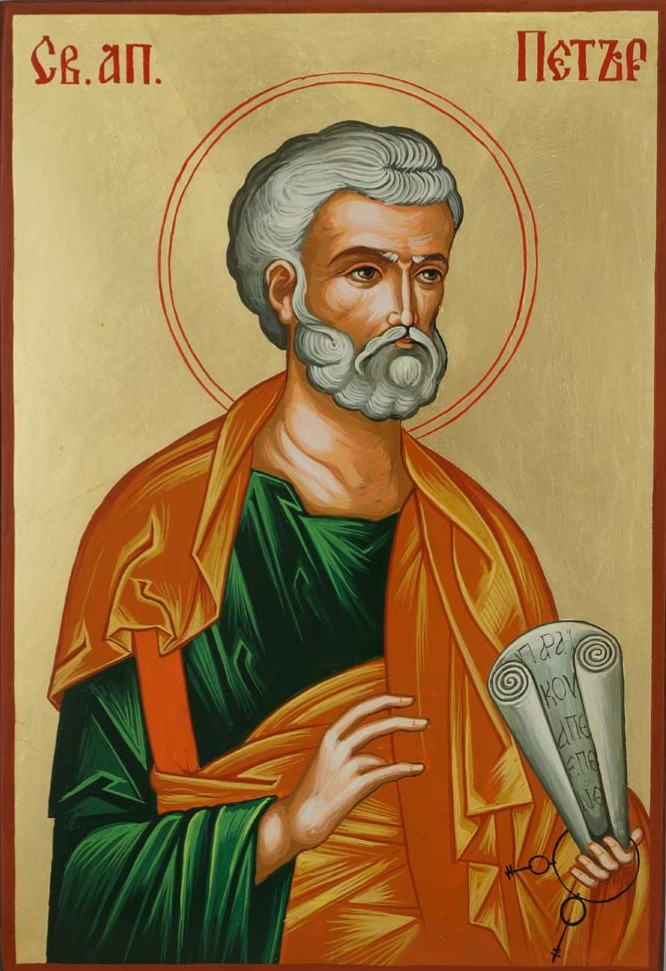by Fr. Patrick Henry Reardon
 Another gem of Scripture and sense from Fr. Patrick, this one comes to us from Orthodoxytoday.org.
Another gem of Scripture and sense from Fr. Patrick, this one comes to us from Orthodoxytoday.org.
Using the narrative third-person, the evangelist John describes his arrival with Peter at the tomb of Jesus:
“So they both ran together, and the other disciple outran Peter and came to the tomb first. And he, stooping down and looking in, saw the linen cloths lying; yet he did not go in. Then Simon Peter came, following him, and went into the tomb; and he saw the linen cloths lying, and the kerchief that had been around His head, not lying with the linen cloths, but folded together in a place by itself.”
Several questions about this kerchief thrust themselves forward: How was it that the two apostles observed and commented on this item? What does their observation tell us about the apostles? What did they conclude from the fact that the kerchief was folded? Finally, what should we surmise from that fact?
With respect to the first question — How was it that the two apostles observed and commented on this item? — it is easy to imagine the thing as part of a police report. Let us picture a detective asking them to describe their discovery of the scene with all the details they can remember.
“Well, officer,” says John, “I arrived first at the tomb, but I did not enter. However, I did stoop down and noticed the linen burial cloths lying there. When Mr. Barjonah arrived, he went into the chamber ahead of me. He’s the one that remarked on the kerchief. It was not lying with the linen burial cloths but was folded together in a separate place by itself.”
“I see,” says the officer, “the kerchief was folded. You are certain of this?”
“Yes,” answers John, “the folded kerchief struck both of us as rather odd. Arriving at the tomb, we presumed that Jesus’ body had been stolen. We did not credit the report of the women in our company who were all worked up, talking about angels and resurrection and the like. Their words seemed to us like idle tales, and we did not believe them. These sisters of ours, you see, had just experienced the trauma of Jesus’ death late last week, so we thought them hysterical when they found the tomb empty.
“When Mr. Barjonah and I arrived there, our first impression of the scene suggested a grave robbery. That folded kerchief, however, was an inconsistent detail. Neither of us could imagine grave robbers stopping to fold that kerchief. This detail got us thinking.”
Perhaps it should get us thinking, too. That kerchief, not lying with the linen cloths, but folded together in a place by itself, was a point of first-hand eyewitness testimony. It puzzled Peter and John, challenging their supposition that the grave had been robbed. John recorded this item for the same reason he included so many other details of that week, namely: “And he who has seen has testified, and his testimony is true; and he knows that he is telling the truth.”
Down through the centuries, no matter what conclusion a someone reached about Jesus’ burial chamber, that folded kerchief has begged for an explanation: Who folded it, and why?
We who accept the testimony of those first female witnesses know exactly who folded the kerchief. We see Him lying dead in the tomb, and then we picture His body coming to a new and completely victorious life.
That instant of the Resurrection of Jesus was the most decisive moment in the history of the world. It was the event of deepest importance for every human being who ever lived. It was the supreme kairos. The Law and the Prophets were fulfilled in that moment, and the existence of the human race took on an utterly new meaning.
What, however, was the first thing Jesus did when the Resurrection life came surging into His body? The simplest and plainest thing imaginable: He reached up, pulled the kerchief from His face, folded it, and set it aside, as though it had been a napkin used at breakfast. Those sacred hands, from which every grace would flow into the Church until the end of the world, were first employed to fold a kerchief.
The universal Christ, the eternal Word in whom all things subsist, was still the same Jesus, to whom an act of elementary neatness came naturally. He spontaneously did what He would likely have done in any case, much as another man might unconsciously scratch his ear, or yet another look around for a stick to whack the weeds with as he walked along.
The risen Lord was the same Jesus His friends had always known. He had just returned from the realm of hell, where He trampled down death by death. He was on the point of going forth as a giant to run His course. He was about to begin appearing to His disciples, providing them with many infallible proofs, being seen by them during forty days, and speaking of the things pertaining to the kingdom of God. Nonetheless, He was still the same person, whose instinctive habits remained identical.
First, He took a moment to fold the kerchief He had used, and only then did He stride out to change the direction of history and transform the lives of human beings.

